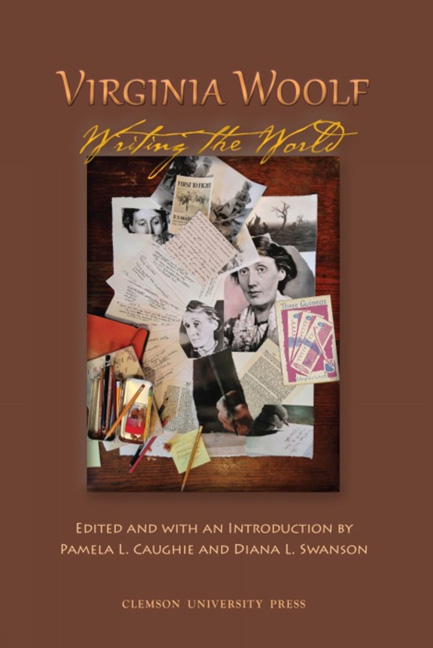Book contents
- Frontmatter
- Table of Contents
- Introduction
- Acknowledgmen
- Abbreviation
- WAR AND PEACE
- WORLD WRITER(S)
- ANIMAL AND NATURAL WORLD
- “And the donkey brays”: Donkeys at Work in Virginia Woolf
- Companion Creatures: “Dogmanity” in Three Guineas
- Virginia Woolf's Object-Oriented Ecology
- The Bodies In/Are The Waves
- Stretching our “Antennae”: Converging Worlds of the Seen and the Unseen in “Kew Gardens”
- “The Problem of Space”: Embodied Language and the Body in Nature in To the Lighthouse
- “Whose Woods These Are”: Virginia Woolf and the Primeval Forests of the Mind
- WRITING AND WORLDMAKING
- Notes on Contributors
- Conference Program
- Appendix: Virginia Woolf Conference Exhibit Items, Newberry Library
The Bodies In/Are The Waves
from ANIMAL AND NATURAL WORLD
- Frontmatter
- Table of Contents
- Introduction
- Acknowledgmen
- Abbreviation
- WAR AND PEACE
- WORLD WRITER(S)
- ANIMAL AND NATURAL WORLD
- “And the donkey brays”: Donkeys at Work in Virginia Woolf
- Companion Creatures: “Dogmanity” in Three Guineas
- Virginia Woolf's Object-Oriented Ecology
- The Bodies In/Are The Waves
- Stretching our “Antennae”: Converging Worlds of the Seen and the Unseen in “Kew Gardens”
- “The Problem of Space”: Embodied Language and the Body in Nature in To the Lighthouse
- “Whose Woods These Are”: Virginia Woolf and the Primeval Forests of the Mind
- WRITING AND WORLDMAKING
- Notes on Contributors
- Conference Program
- Appendix: Virginia Woolf Conference Exhibit Items, Newberry Library
Summary
From around 1860 to 1920, a new concept dominated theories of physiology, a concept curiously similar to the fragmentation of modernist art and literature. Historians of neuroscience describe this as the “era of localization” (Finger 323). Localization is a theory that the human brain does not function as a coherent whole but rather is a collection of separate, localized organs, each of which generates a distinct part of consciousness. What we experience then is not simply a reflection of the world which our intelligence interprets but rather more like a collage painted by multiple painters all working at the same time. The parallel to the fragmented structure of many modernist paintings seems fairly straightforward. And localization provides an intriguing way to understand The Waves (1931).
Localization broke down the distinction between mind and body: as scientists demonstrated that physically altering the brain (in accidents or during surgery) altered or even created thoughts, it became commonplace to conclude that consciousness does not derive entirely from a “self” or a “soul” or any other non-physical entity. According to the historian Roger Smith, localization “suggested physical analogues for functions that were previously considered the expression of nonphysical, mental, or vital powers. Localization thus enabled description of living and mental processes as part of the natural world” (17). Localization also extended beyond the brain to suggest that other parts of the body could contribute to consciousness. In 1884, William James defined emotion as “felt awareness of visceral activity,” which led to the widespread belief in the early twentieth century that emotions were “inherently bodily, involuntary and irrational” (Dixon, 24, 2). External things then seemed able to directly interact with the “viscera” or with subsections of the brain and produce reactions quite independent of the overall “self.” Along with Darwinian conceptions, localization led many writers to see humans as in large part acting as animals, not merely controlling the animal parts of themselves.
In her essay “On Being Ill,” Woolf indicates that she saw the power of the body to shape consciousness as undermining what literature had generally presented:
with a few exceptions […] literature does its best to maintain that its concern is with the mind; that the body is a sheet of plain glass through which the soul looks straight and clear. […] On the contrary, the very opposite is true.
- Type
- Chapter
- Information
- Virginia Woolf: Writing the World , pp. 154 - 159Publisher: Liverpool University PressPrint publication year: 2015

